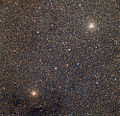NGC 6528
Appearance
| NGC 6528 | |
|---|---|
 The globular cluster NGC 6528 Credit: HST | |
| Observation data (J2000 epoch) | |
| Class | V |
| Constellation | Sagittarius |
| Right ascension | 18h 04m 49.61s[1] |
| Declination | −30° 03′ 20.8″[1] |
| Distance | 25.8 kly (7.9 kpc)[1] |
| Apparent magnitude (V) | 10.65[1] |
| Physical characteristics | |
| Radius | 8.3' x 8.3'[2] |
| Metallicity | = -0.11[3] dex |
| Other designations | GCl 84, ESO 456-48, VDBH 257[1] |
NGC 6528 is a globular cluster in the constellation Sagittarius, and is listed in the New General Catalogue. It has an apparent magnitude of about 11 and a diameter of about 16 arcminutes, and its Shapley-Sawyer Concentration Class is V, containing stars of 16th magnitude and dimmer.[2] Dreyer described it as "pF, cS, R", meaning poor and faint, considerably small and round.
NGC 6528 is located southwest of NGC 6522, another globular cluster. Both are located in Baade's Window, a relatively clear area near the galactic equator.
The globular cluster was discovered in 1784 by the astronomer William Herschel with his 18-inch telescopes.
Gallery
-
The globular cluster NGC 6528 (lower left) is close to NGC 6522 (upper right)
-
The cluster is located in Baade's Window, a region of night sky that is not clouded by dust from the Milky Way.
References
- ^ a b c d e "NGC 6528". SIMBAD. Centre de données astronomiques de Strasbourg. Retrieved 8 January 2017.
- ^ a b "NGC 6528". Retrieved 8 January 2016.
- ^ "A Galactic Globular Clusters Database: NGC 6528". Retrieved 8 January 2017.
- Robert Burnham, Jr, Burnham's Celestial Handbook: An observer's guide to the universe beyond the solar system, vol 3, p.1555
- NGC 6528 @ SEDS
External links
 Media related to NGC 6528 at Wikimedia Commons
Media related to NGC 6528 at Wikimedia Commons

![{\displaystyle {\begin{smallmatrix}\left[{\ce {Fe}}/{\ce {H}}\right]\end{smallmatrix}}}](https://wikimedia.org/api/rest_v1/media/math/render/svg/4c0821bd80891e071c08e7c7ee8e022baedf522c)

